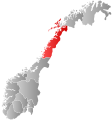Fauske
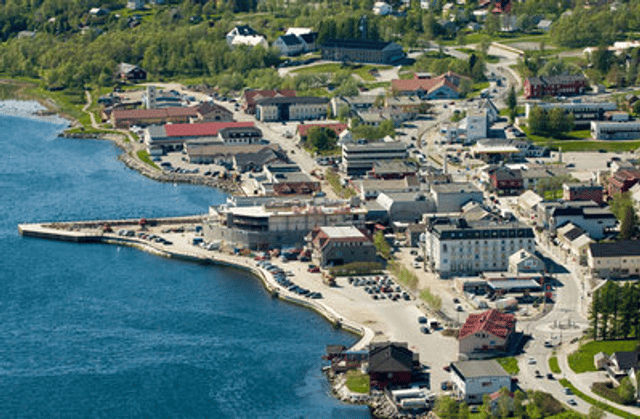
Fauske

Fauske kommune Fuosko suohkan | |
|---|---|
Municipality | |
 Fauske within Nordland | |
| Coordinates:67°13′14″N 15°48′31″E [18] | |
| Country | Norway |
| County | Nordland |
| District | Salten |
| Established | 1 Jan 1905 |
| Administrative centre | Fauske |
| Government | |
| • Mayor(2015) | Jørn Stene (Local list) |
| Area | |
| • Total | 1,204.75 km2(465.16 sq mi) |
| • Land | 1,107.33 km2(427.54 sq mi) |
| • Water | 97.42 km2(37.61 sq mi) 8.1% |
| Area rank | 83 in Norway |
| Population (2018) | |
| • Total | 9,775 |
| • Rank | 115 in Norway |
| • Density | 8.8/km2(23/sq mi) |
| • Change(10 years) | 3.1% |
| Demonym(s) | fauskeværing fauskværing[1] |
| Time zone | UTC+01:00 (CET) |
| • Summer (DST) | UTC+02:00 (CEST) |
| ISO 3166 code | NO-1841 |
| Official language form | Bokmål |
| Website | fauske.kommune.no [19] |
Data from Statistics Norway [20] | |
Fauske (Norwegian) or Fuossko (Lule Sami)[2] is a municipality located in Nordland county, Norway. It is part of the traditional district of Salten. The administrative centre of the municipality is the town of Fauske. Some of the villages in Fauske include Nystad, Venset, Straumsnes, and Sulitjelma.
The municipality borders Sweden in the east and the municipalities of Sørfold to the north, Bodø to the west, and Saltdal to the southeast. The town is located on the northern shore of Skjerstad Fjord.
The 1,205-square-kilometre (465 sq mi) municipality is the 83rd largest by area out of the 422 municipalities in Norway. Fauske is the 115th most populous municipality in Norway with a population of 9,775. The municipality's population density is 8.8 inhabitants per square kilometre (23/sq mi) and its population has increased by 3.1% over the last decade.[3][4]
Fauske kommune Fuosko suohkan | |
|---|---|
Municipality | |
 Fauske within Nordland | |
| Coordinates:67°13′14″N 15°48′31″E [18] | |
| Country | Norway |
| County | Nordland |
| District | Salten |
| Established | 1 Jan 1905 |
| Administrative centre | Fauske |
| Government | |
| • Mayor(2015) | Jørn Stene (Local list) |
| Area | |
| • Total | 1,204.75 km2(465.16 sq mi) |
| • Land | 1,107.33 km2(427.54 sq mi) |
| • Water | 97.42 km2(37.61 sq mi) 8.1% |
| Area rank | 83 in Norway |
| Population (2018) | |
| • Total | 9,775 |
| • Rank | 115 in Norway |
| • Density | 8.8/km2(23/sq mi) |
| • Change(10 years) | 3.1% |
| Demonym(s) | fauskeværing fauskværing[1] |
| Time zone | UTC+01:00 (CET) |
| • Summer (DST) | UTC+02:00 (CEST) |
| ISO 3166 code | NO-1841 |
| Official language form | Bokmål |
| Website | fauske.kommune.no [19] |
Data from Statistics Norway [20] | |
General information
The municipality was established on 1 January 1905 when the municipality of Skjerstad was divided into Skjerstad (population: 1,709) in the west and Fauske (population: 4,646) in the east. The municipal borders haven't changed since that time. In 1998, the municipality declared township for its administrative centre.[5]
Name
Coat of arms
The coat of arms was granted in 1988. The arms show a red reef knot on a gray background. It was chosen to represent Fauske as a center of commerce and transportation for the region.[7][8]
Churches
The Church of Norway has three parishes (sokn) within the municipality of Fauske. It is part of the Salten prosti (deanery) in the Diocese of Sør-Hålogaland.
| Parish (sokn) | Church Name | Location of the Church | Year Built |
|---|---|---|---|
| Fauske | Fauske Church | Fauske | 1867 |
| Sulitjelma | Sulitjelma Church | Sulitjelma | 1899 |
| Sulitjelma Chapel | Sulitjelma | 1996 | |
| Valnesfjord | Valnesfjord Church | Valnesfjord | 1905 |
Economy
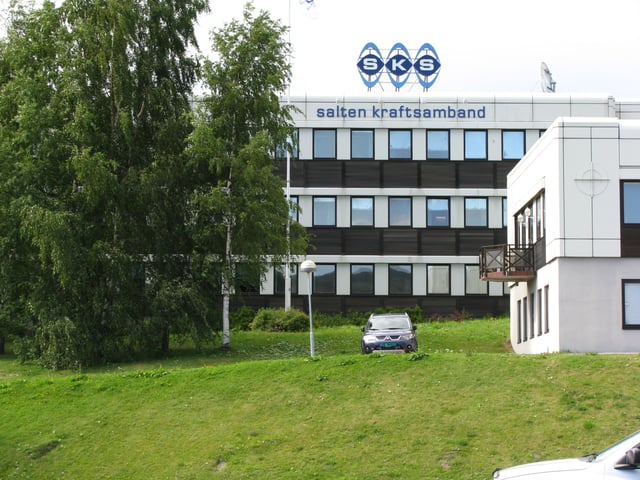
Several power companies have offices in Fauske
Several marble quarries are located in the municipality. The marble is exported to many countries, where it can be observed in many monumental buildings, among them the United Nations Headquarters in New York City. There are also dolomite quarries in Fauske, as well as some agriculture. Salten Kraftsamband and Fauske Lysverk are important employers in Fauske. The town is a commercial centre for parts of the inland areas of Salten, and has hotel and camping facilities. FK Fauske/Sprint is the local soccer team. Historically, mining in Sulitjelma was very important.
Government
All municipalities in Norway, including Fauske, are responsible for primary education (through 10th grade), outpatient health services, senior citizen services, unemployment and other social services, zoning, economic development, and municipal roads. The municipality is governed by a municipal council of elected representatives, which in turn elect a mayor.[9] The municipality falls under the Salten District Court and the Hålogaland Court of Appeal.
Municipal council
| Party Name | Name in Norwegian | Number of representatives | |
|---|---|---|---|
| Labour Party | Arbeiderpartiet | 5 | |
| Progress Party | Fremskrittspartiet | 3 | |
| Conservative Party | Høyre | 3 | |
| Christian Democratic Party | Kristelig Folkeparti | 1 | |
| Red Party | Rødt | 2 | |
| Socialist Left Party | Sosialistisk Venstreparti | 1 | |
| Liberal Party | Venstre | 1 | |
| Local Lists | Lokale lister | 11 | |
| Total number of members: | 27 | ||
Transportation
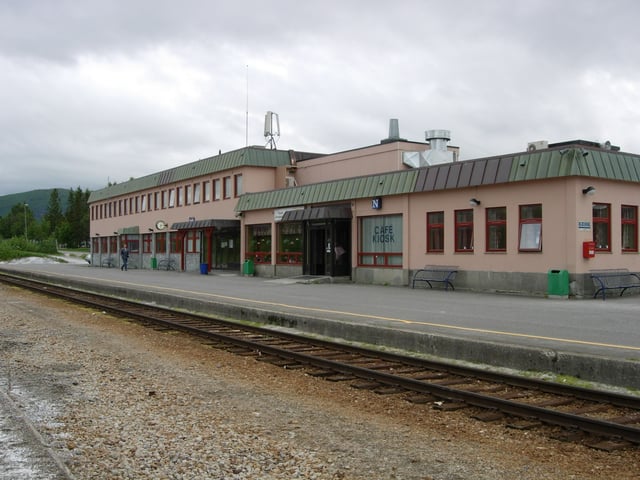
Railway station in Fauske; an important junction for many travellers. Fauske and Bodø are the most northerly stations on the main railway network in Norway.Photo: Lars Røed Hansen
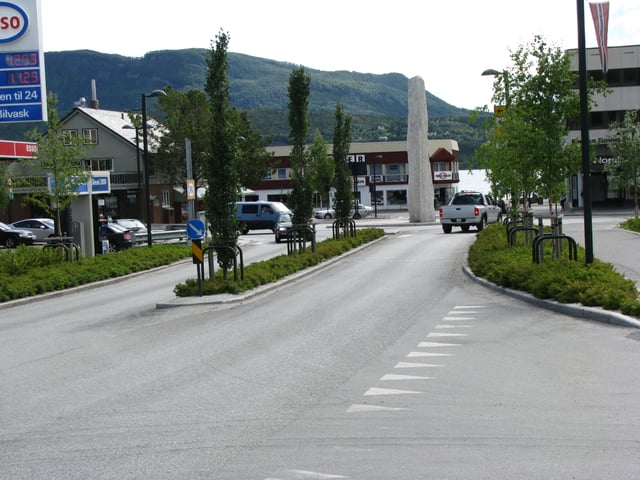
The E6 - Rv 80 road junction in the centre of Fauske
The Nordland Line passes through the municipality, reaching Bodø west of Fauske. Travellers going further north usually leave the train in Fauske, and travel by express bus to Narvik or further, using European route E6 which goes through the center of Fauske. The E6 from Mo i Rana north to Fauske crosses over the Saltfjellet mountains, and the E6 further north to Narvik also goes through very rugged terrain; these are among the most scenic drives in Norway, although there are many tunnels in the Sørfold area. The Norwegian national road Rv 80 to Bodø, about 62 kilometres (39 mi) to the west, departs from E6 in the centre of Fauske.
The Norwegian County Road 830 runs from the town of Fauske to the east to the village of Sulitjelma. The road passes through several tunnels: Grønnlifjell Tunnel, Hårskolten Tunnel, Sjønståfjell Tunnel, and Stokkviknakken Tunnel. The road follows the old Sulitjelma Line railroad.
Nature
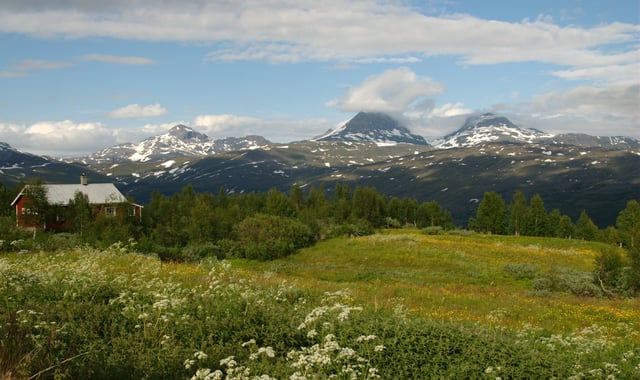
Early July and summer in the highlands at Jakobsbakken, near Sulitjelma.
There are two large glaciers in Fauske: Blåmannsisen and the Sulitjelma Glacier; covering about 14% of the municipality. The highest mountain is Suliskongen at 1,907 metres (6,257 ft) above sea level. There are many lakes in the municipality, such as Blåmannsisvatnet, Kjelvatnet, Låmivatnet, Langvatnet, Muorkkejávrre, Nedrevatnet, Øvrevatnet, and Vuolep Sårjåsjávrre.
Climate
Fauske is located inside the Arctic circle and has 24 hours of daylight from early May to the beginning of August, with midnight sun from the beginning of June to the second week of July. The area nearly has polar night for part of December because it has sunrise at 11 am and sunset before noon. Average 24-hour temperatures in Fauske is below freezing from mid-November to the last part of March, but the ice-free Skjerstad Fjord moderates winter temperatures. Summer starts in June with moderate summer temperatures lasting until early September.
Precipitation is heaviest from September to December (usually as snow in December); average annual precipitation is 1,040 millimetres (41 in). Daytime temperatures are usually significantly warmer than the 24-hr average from March to September, while there is very little diurnal temperature variation from November to early February as the sun is very low or below the horizon all day. However, temperatures varies considerably with the weather; there might be cool westerly winds with temperatures of 10 °C (50 °F) and rain both night and day in July, and the next day might be sunny with daytime temperature reaching 25 °C (77 °F). Southwesterly winds can bring thaws anytime in winter, but not in the mountains, which usually get large amounts of snow in winter—the main reason for the large glaciers and the hydropower in the area.
| Climate data for Fauske | |||||||||||||
|---|---|---|---|---|---|---|---|---|---|---|---|---|---|
| Month | Jan | Feb | Mar | Apr | May | Jun | Jul | Aug | Sep | Oct | Nov | Dec | Year |
| Daily mean °C (°F) | −4.2 (24.4) | −3.6 (25.5) | −1.7 (28.9) | 2.1 (35.8) | 7.4 (45.3) | 11.2 (52.2) | 13.0 (55.4) | 12.5 (54.5) | 8.5 (47.3) | 4.4 (39.9) | −0.5 (31.1) | −3.0 (26.6) | 3.8 (38.8) |
| Average precipitation mm (inches) | 98 (3.9) | 81 (3.2) | 75 (3.0) | 53 (2.1) | 45 (1.8) | 53 (2.1) | 78 (3.1) | 79 (3.1) | 110 (4.3) | 147 (5.8) | 105 (4.1) | 116 (4.6) | 1,040 (40.9) |
| Source: [15] | |||||||||||||
Notable residents
![Fauske marble, known as Norwegian Rose; can also be green-white ([1] ).](https://everipedia.org/cdn-cgi/image/width=640/https://upload.wikimedia.org/wikipedia/commons/6/6e/Fauske_marble.jpg)
Fauske marble, known as Norwegian Rose; can also be green-white ([1] [21] ).
Christel Alsos, musician
Trine Angelsen, author
"Fattern", musician
Dag Ove Johansen, author
Alexander Os, biathlete
Karin Risvoll, author
Simon Slåttvik (born 24 July 1917 in Valnesfjord), skier in the Nordic combined event who was a gold medallist at the 1952 Winter Olympics in Oslo
Dag Egil "Lille" Rugås, "Farmen"-participant

